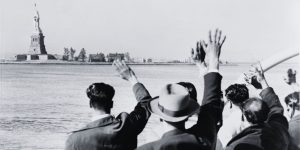What Happened On July 4th?
July 4th stands as a key date in American history, symbolizing both the nation’s birth and a lasting international friendship. On this day in 1776, the Continental Congress adopted the Declaration of Independence, asserting the American colonies’ right to self-governance and freedom from British rule.
More than a century later, on July 4, 1884, France gave the United States the Statue of Liberty, symbolizing liberty and the strong bonds between the two nations. Both events, occurring on the same date, highlighted the enduring values of freedom and solidarity that defined the American spirit.
A Declaration of Defiance
Months of rising tensions with Britain led to the Declaration of Independence. The battles of Lexington and Concord in April 1775 had started the Revolutionary War. By the summer of 1776, the call for independence became overwhelming. Thomas Jefferson, a young Virginian, wrote the Declaration, emphasizing government by the people’s consent and inalienable rights.
On July 4th, the Continental Congress gathered to review Jefferson’s draft. The room filled with anticipation and solemnity. After debate and minor changes, the delegates were ready to act. John Hancock, President of the Congress, signed the document boldly. As each delegate signed, the Declaration became a powerful symbol of liberty and resolve.
Not all delegates signed on July 4. Only Hancock and Charles Thomson, the Secretary of Congress, signed that day. Most delegates signed on August 2, 1776, after it had been copied onto parchment by Timothy Matlack, a skilled clerk.
Proclaiming Independence
The Declaration’s opening, stating “all men are created equal,” had a powerful impact. The listed grievances against King George III justified rebellion, reflecting the colonists’ sense of betrayal and injustice.

As news of the Declaration spread, people gathered to hear the words read aloud. They rang bells, fired muskets, and lit bonfires. In New York City, General George Washington had the Declaration read to his troops, renewing their purpose as they faced British forces.
Contrary to popular belief, the Liberty Bell in Philadelphia did not ring on July 4, 1776. Historians think it might have rung on July 8th, when the Declaration was first publicly read in the city.
A Gift of Friendship and Liberty
On July 4, 1884, the United States received a grand gift from France—the Statue of Liberty. This statue became an enduring symbol of freedom and democracy. “Liberty Enlightening the World,” as it was officially named, was presented in a ceremony in Paris.
Shared Ideals In Stone
French political thinker and abolitionist Édouard René de Laboulaye came up with the idea for the statue. He saw it as a gift celebrating the centennial of the American Declaration of Independence and symbolizing shared values of liberty between France and the United States. Sculptor Frédéric Auguste Bartholdi designed the statue, and Gustave Eiffel handled the engineering.
Bartholdi’s mother, Charlotte, inspired the statue’s face. Her dignified expression conveyed liberty’s enlightened nature. The seven rays of Liberty’s crown represented the seven continents, emphasizing universal freedom.

The statue was built in France and then taken apart for shipment across the Atlantic. On July 4, 1884, Bartholdi’s creation was officially handed over to Levi P. Morton, the American minister to France, in a grand ceremony. This day highlighted the deep historical ties between the two nations.
Lady Liberty’s Journey
Transporting the statue to New York Harbor was a huge task. The disassembled statue, packed in over 200 crates, arrived in the United States in June 1885. The pedestal, funded by American donations led by newspaper magnate Joseph Pulitzer, was still being built on Bedloe’s Island (now Liberty Island).
Pulitzer’s campaign, which published the names of every donor in his newspaper, the New York World, spurred widespread public support and raised the necessary funds.
Finally, on October 28, 1886, President Grover Cleveland unveiled the Statue of Liberty in a ceremony attended by thousands. The statue’s arrival and dedication were celebrated with great enthusiasm, symbolizing hope and a welcoming sight for immigrants arriving by sea.
The torch Lady Liberty held was originally designed to be a lighthouse, but the technology of the time was insufficient. Instead, it remained a powerful symbol of enlightenment and hope.
Echoes of Liberty
John Adams, writing to his wife Abigail Adams, a delegate in Philadelphia, captured the day’s spirit in 1776: “I am apt to believe that it will be celebrated, by succeeding generations, as the great anniversary festival. It ought to be commemorated as the day of deliverance, by solemn acts of devotion to God Almighty.”
In 1884, upon presenting the Statue of Liberty, Bartholdi expressed his sentiments: “May this monument to liberty spread its rays over the world and remain an enduring pledge of the affection of the French people to the American people.”





